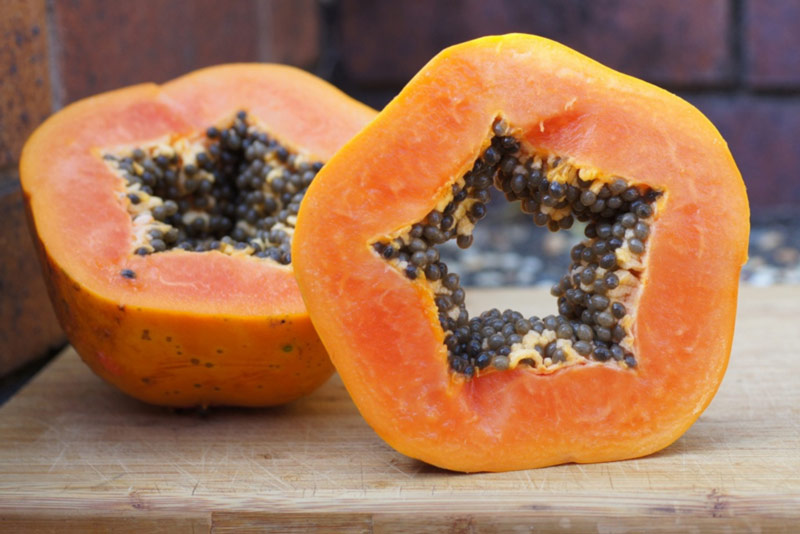Due to its composition rich in vitamins A and C, calcium, enzymes and dietary fibers that stimulate digestion, and have a major role in maintaining the immune system, papaya is often called the “fruit of angels.”
Papaya is a fruit of the tree of the genus Caricae, and grows in the tropical regions of Central and South America. Increases from 5 to 10 feet tall with spirally arranged leaves (the leaves are long and 70 cm) connected to the top of the tree. The lower part of the tree is leafless and then developing fruits. Papaya fruits are large, 15-45 cm. Papaya fruit is slightly elongated, like melons usually green or yellow. Meat taste like melon, light orange with black seeds (which can not be eaten). It is used in the same manner as melons.
When ripe, the fruits are yellowish or dark red. To taste similar to pineapple and peach. It is interesting that there is a male and female tree. Papaya is rich in biologically active compounds of which the major component of papain. Commonly take leaves, root, fruit. Equally male papaya tree is different from the female composition – eg. female tree has a higher concentration of the papain. Effect of therapy preparations papaya depends on the amount of different compounds in the formulation.
Why is the papaya healthy?
The extract of dried leaves of papaya has an anticancer effect, and it against a broad spectrum of tumors – including breast and uterine cervix, breast, liver, lung and pancreas. Also, the healthy and the kidneys, and can help in stopping and controlling diabetes. If you eat papaya every day, it can help in weight loss. It also reduces the chances of heart attack. The fruit of papaya can be eaten fresh or as dried fruit. From unripe fruit is obtained by the enzyme papain, which promotes digestion and breakdown of food. In this way the food is retained in the stomach short, prevents swelling and stimulates the breakdown of fats.
Parts of the plant
Dairy papaya juice is used in the treatment of diseases of the skin, intestine, constipation, and the detoxification of the digestive system, diseases caused by bacteria such as Candida albicans, Bacillus subtilis, Escherichia coli, Entamoeba histolytica, aureua Staphylococcus, Salmonella typhi. It is good natural remedy for muscle relaxation. The milky juice of leaves has karpain from which it receives papaiacin, used to treat asthma (blowing the leaves of papaya) against nerve diseases and as an antioxidant in skin and stomach diseases, as well as detoxification.
The use of seeds and flower
Seeds, commonly used as a spice because they taste like pepper, and have the property that is well-off thirst. Color is used for the treatment of hepatitis, and as an anti-parasitic agent. At higher concentrations cause infertility. Leaves and roots of papaya contain clonidine glycosides that produce cyanide, and leaves contain tannin. If both the compound of the taken in large amounts can have undesirable effects. Caution is advised in patients taking warfarin.
Photo by Tatters CC BY
 Healthy Life and Beauty Health and Beatuy information and advice you can trust.
Healthy Life and Beauty Health and Beatuy information and advice you can trust.




